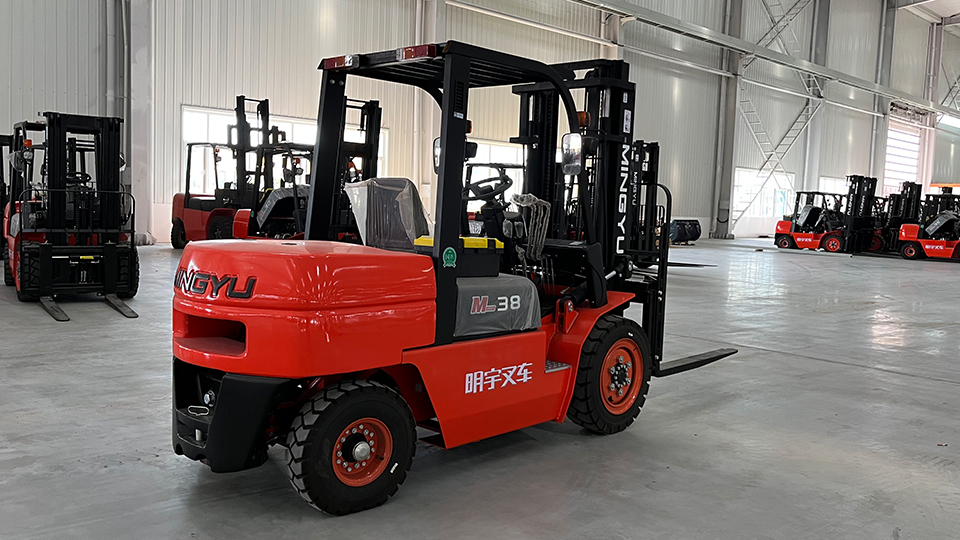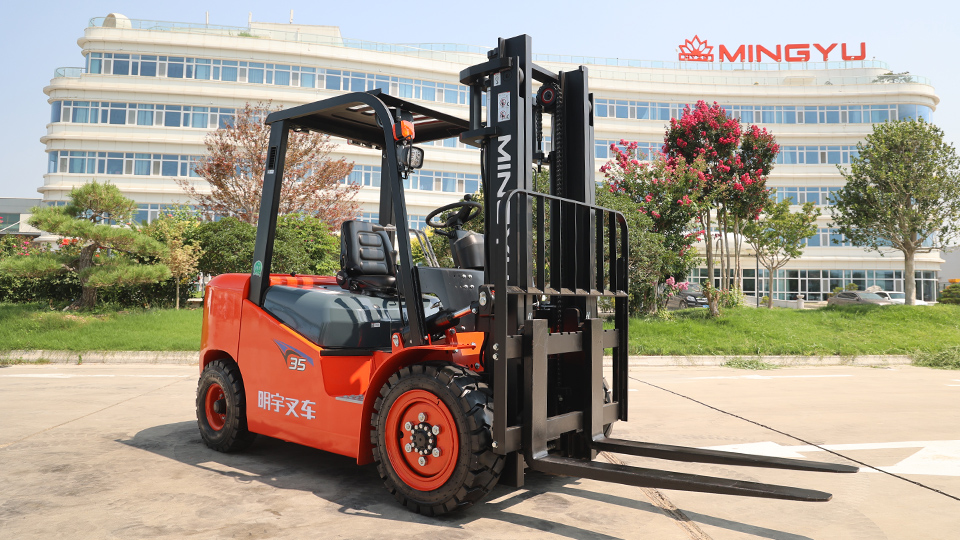
0. Executive summary
Gradeability is the steepest slope, expressed in percent grade or degrees, that a forklift can negotiate at a specified speed without stalling, overheating, or losing traction. 2025 production models range from 10 % (6 °) for small warehouse electrics to 38 % (21 °) for 5 t diesel counterbalances and 25 ° for telehandlers when unladen. The value is dictated by tractive effort, power-line hydraulics, tyre compound, ground clearance, and stability under the ISO 22915 lateral overturning test. This article explains the physics, shows how OEMs calculate the number, presents 2025 data, and gives fleet managers rules for matching ramps to trucks.
1. Definition and units
Gradeability = (Rise / Run) × 100 %.
1 % grade = 0.57 °; 100 % = 45 °.
Forklift datasheets quote two numbers:
Laden: truck carrying rated load, worst-case mast tilt, 1.6 km h⁻¹ (walkie) or 3–5 km h⁻¹ (ride-on).
Unladen: forks empty, usually 20–30 % higher because drive-axle load is lower and engine has surplus power.
2. Physics in one equation
The longitudinal force balance on a slope is:
Fₜᵣₐcₜᵢᵥₑ = mg(sin θ + fᵣ cos θ) + Fₐᵢᵣ + Fᵣₒₗₗ
where
Fₜᵣₐcₜᵢᵥₑ = wheel torque × gear ratio × drivetrain efficiency / tyre radius

m = total mass (truck + load)
θ = slope angle
fᵣ = rolling resistance coefficient (0.015 hard tyre on concrete, 0.035 pneumatic on dirt)
Fₐᵢᵣ = ½ρCdAv² ≈ negligible below 10 km h⁻¹
Fᵣₒₗₗ = bearing and mast chain drag, ≈ 50 N per 1 t.
Re-arranging gives the theoretical maximum grade:
θₘₐₓ = arcsin[ (Fₜᵣₐcₜᵢᵥₑ / mg) − fᵣ ]
Equation (1) is embedded in every OEM performance program.
3. What limits traction?
Drive-axle load: on a 5 t diesel forklift only 35 % of laden weight is on the front axle when ascending; the rear axle must provide torque.
Tyre compound: soft-compound pneumatics increase µ from 0.35 to 0.55 on dry asphalt.
Surface contamination: 0.1 mm dust lowers µ to 0.2—gradeability drops by half.
Mast tilt: ISO 22915 allows 2 ° forward tilt on slope; every extra degree transfers 3 % load away from the drive axle.
Hydraulic relief: travel circuit pressure is capped to protect pumps; this caps wheel torque and hence gradeability.
4. Regulatory and safety overlays
OSHA 1910.178: classifies any incline > 10 ° as a “ramp”; operator must face uphill, load upgrade, speed ≤ 5 km h⁻¹.
ISO 22915-8: stability test requires truck to remain stable on a 13 % (7.4 °) tilt table with load at full height; most OEMs therefore derate practical gradeability to 80 % of the test angle.
EU 2023/1326: emission Stage V vehicles must not exceed 1,550 rpm during 30 s grade test to control NOx; this slightly lowers certified gradeability compared with pre-2021 specs.
5. 2025 production data snapshot
Numbers are taken from operator manuals dated January–October 2025.
Class Model Laden Grade % Laden Grade ° Unladen % Notes
III EP CPD10 10 5.7 15 1 t electric
I FB20 (China) 15 8.5 20 2 t electric
V CPCD30K diesel 20 11.3 30 3 t pneumatic
V LYMG CPCD35FR 15 8.5 20 3.5 t
V Heli CPCD50 33 18.3 20 5 t
V CPCD50 (alt. source) 38 21.0 19 High-torque engine
VII XC6-4517K telehandler 46 25 — 4.5 t, 17 m reach
Electric trucks are traction-motor limited; diesels are engine-torque limited; rough-terrain telehandlers are stability limited at boom heights > 8 m.
6. Why electrics climb lower
Motor torque: a 48 V, 11 kW traction motor produces 220 Nm at shaft; through 12:1 reduction and 0.33 m tyre radius this gives 8 kN tractive force—enough for 10 % grade with 2 t load.
Battery sag: at 20 % state-of-charge, pack voltage falls 8 %; torque and gradeability drop proportionally.
Thermal: motor windings reach 150 °C after 60 s on 15 % grade; controller derates current → gradeability falls to 8 %.
Therefore premium 2025 electrics (e.g., Toyota 8FBE20) now use 96 V lithium packs and water-cooled motors to sustain 15 % laden continuously.
7. Diesel torque surplus
A 3.8 L Kubota V3800 rated 82 kW @ 2,200 rpm delivers 420 Nm. Through a 18:1 auto powershift and 0.45 m pneumatic tyre, static tractive force is 16.8 kN. Against a 7 t laden mass, Equation (1) predicts 22 % grade on concrete. OEM catalogues list 20 % to provide a 10 % safety margin for tyre wear and low-pressure situations.
8. Telehandler exception
Telehandlers are graded by “angle” rather than percent because construction sites quote slopes in degrees. The XC6-4517K achieves 25 ° (46 %) unladen thanks to 2.5 m wheelbase, 70 kN traction, and limited-slip axles. With 4.5 t at 17 m height, stability drops to 8 ° (14 %)—still above the 6 ° required by EN 1459.
9. Measurement protocol (ISO 22915-21:2025)
Warm engine to 70 °C coolant, tyres to 35 °C.
Position truck on variable-angle platform, forks 300 mm above deck, mast vertical, rated load.
Increase slope by 0.5 ° increments; maintain 3 km h⁻¹.
Gradeability = highest angle sustained for 30 s without wheel-slip, engine stall, or activation of traction-cut.
Repeat in both directions; lowest value is certified.
10. Ramp design checklist for users
Given OSHA limits and OEM data, apply these rules:
Design ramp slope ≤ 80 % of laden gradeability to allow for worn tyres, rain, operator variance.
Length: for every 1 % grade, add 0.6 m run; a 15 % ramp needs 9 m to rise 1.35 m.
Surface: broom-finished concrete µ ≈ 0.55; painted steel plate µ ≈ 0.25—avoid.
Drainage: 1 % cross-fall prevents water film that halves traction.
Transition flats: provide 1.5 m flat at top and bottom to prevent ground strike; mast tilt angles are 6 °/12 °.
Signage: post “Maximum slope 15 %” if trucks rated 20 % are used; this covers liability.
11. Worked example
Problem: A warehouse installs a 14 %, 12 m long ramp. Can a 2.5 t electric truck (gradeability 15 % laden) operate safely?
Solution:
14 % < 15 % → technically OK.
Apply 80 % rule: 0.8 × 15 % = 12 %; 14 % > 12 % → NO, redesign ramp to 12 % or select truck with ≥ 18 % gradeability.
Upgrade to a 96 V model rated 18 %, or add a winch-assist dock.
12. Future trends (2026–2028)
In-wheel motors: twin 8 kW hub motors on rear axle add 4 kN tractive force; expected to raise electric gradeability to 20 %.
Variable-torque split: Hyster’s “HydraBoost” uses hydraulic accumulators to deliver 25 kN for 5 s, enough to start on 25 % grade without oversizing the motor.

Semi-track option: Manitou’s RT 420 ST replaces front tyres with 280 mm rubber tracks; gradeability climbs to 40 % (22 °) on mud.
Dynamic stability control: IMU-based system reduces tilt-cyl pressure on steep slopes, recovering 2 ° of practical gradeability while staying within ISO 22915.
13. Key takeaways
Never quote a single “maximum gradeability”; always state laden, unladen, surface, and speed.
Electric counterbalances top out at 15 % in 2025; for steeper ramps, specify diesel or hybrid.
33 % (18 °) is the practical ceiling for 3–5 t IC forklifts on solid tyres; beyond that, use rough-terrain or telehandler.
ISO 22915 certification is 20 % lower than theoretical tractive limit—this is the safety margin.
Ramp slope should be ≤ 80 % of truck laden gradeability, cross-drained, and equipped with 1.5 m transition flats.
By integrating these physics-based limits into facility design and procurement specs, fleet managers eliminate the largest single cause of forklift overturn accidents and avoid costly last-minute ramp retrofits.
Name: selena
Mobile:+86-13176910558
Tel:+86-0535-2090977
Whatsapp:8613181602336
Email:vip@mingyuforklift.com
Add:Xiaqiu Town, Laizhou, Yantai City, Shandong Province, China